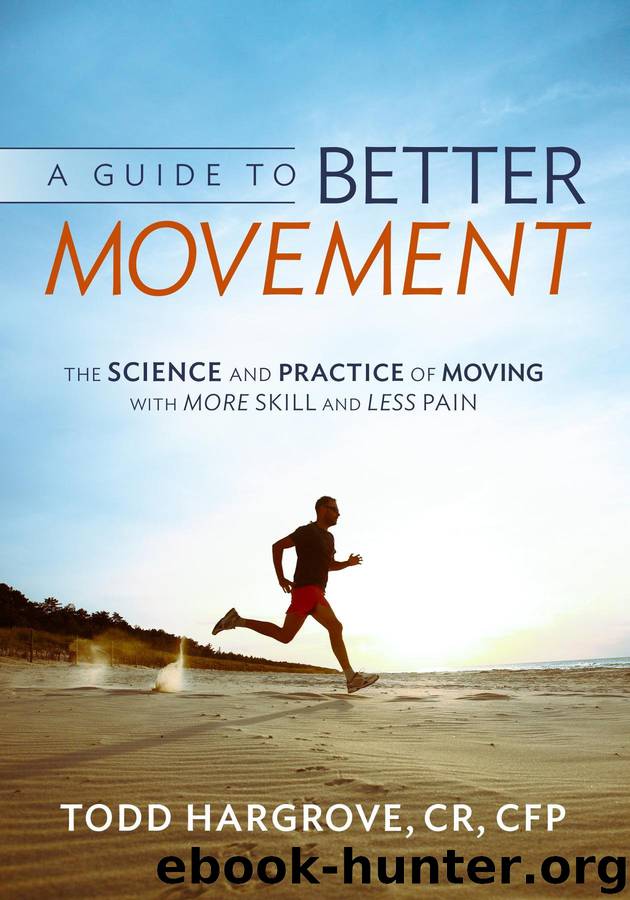A Guide to Better Movement: The Science and Practice of Moving With More Skill and Less Pain by Todd R. Hargrove

Author:Todd R. Hargrove [Hargrove, Todd R.]
Language: eng
Format: epub
Tags: Health, rehabilitation, injuries, Exercise, proprioception, pain science, coordination, Physical Therapy, chronic pain, Feldenkrais, fitness, Neuroscience, movement
ISBN: 9780991542307
Google: TejroAEACAAJ
Amazon: 0991542304
Goodreads: 22332502
Publisher: Better Movement
Published: 2014-05-20T21:00:00+00:00
Common Mechanisms for Pain Relief
So what can we do with all this information? Based on the science discussed in this chapter, following are some common mechanisms by which different movement practices or manual therapies could be expected to reduce pain.
First, a word of caution. Reading the strategies below is no substitute for getting medical attention. Make sure to see a qualified medical professional for treatment of any pain.
Reducing nociception
The most obvious and commonly used strategy for treatment of pain is to find and eliminate sources of nociception near the area that hurts. This might be done through altering biomechanics, trying to get rid of trigger points, reducing excess muscle tension, freeing restrictions on healthy nerve movement, avoiding provocative movements, getting surgery, etc. This strategy is so obvious it almost goes without saying, but it bears mention for a couple reasons.
First, many pain interventions begin and end with this strategy while ignoring others. That is unfortunate.
Second, it is often assumed that when a treatment is effective at reducing pain, it worked by reducing nociception. Because pain is modulated by many factors, this is an invalid assumption that leads to confusion. For example, just because you feel better after massage or acupuncture or stretching doesn’t mean that what you did corrected any damage in the tissues.
Third, identifying an exact source of nociception and determining an effective remedy is often very difficult. There are many tough questions. Is the source of nociception mechanical or chemical? Are the signals resulting from damage to muscles, tendons, ligaments, fascia, viscera or nerves? Do the signals originate from a nerve ending or a nerve trunk? Is there sensitization peripherally or centrally? What is the role of descending influences?
Is inflammation a significant player and why is it there? Answering these questions is far beyond the scope of this book, and requires significant training and expertise. But just knowing the questions exist is a way to protect against overconfidence and unwarranted assumptions in diagnosing the origin of nociception in any particular case.
Thus, although finding and reducing nociception should be a primary goal of any attempt to reduce pain, it will often require individualized analysis and treatment from a skilled expert. And, despite best efforts, the result will often be frustration. By contrast, many of the pain relief strategies described below, most of which target inputs aside from nociception, are relatively easy to apply, and are likely to benefit a wide range of conditions and people. In fact, they are probably sufficient to explain most of the results seen in most therapies, most of which mistakenly claim to work by reducing nociception!
Download
This site does not store any files on its server. We only index and link to content provided by other sites. Please contact the content providers to delete copyright contents if any and email us, we'll remove relevant links or contents immediately.
Men In Love by Nancy Friday(4365)
Everything Happens for a Reason by Kate Bowler(4081)
The Immortal Life of Henrietta Lacks by Rebecca Skloot(3843)
Why We Sleep by Matthew Walker(3798)
The Sports Rules Book by Human Kinetics(3612)
Not a Diet Book by James Smith(2756)
The Emperor of All Maladies: A Biography of Cancer by Siddhartha Mukherjee(2446)
Sapiens and Homo Deus by Yuval Noah Harari(2434)
Day by Elie Wiesel(2256)
Endless Forms Most Beautiful by Sean B. Carroll(2095)
Angels in America by Tony Kushner(2060)
A Burst of Light by Audre Lorde(1988)
Hashimoto's Protocol by Izabella Wentz PharmD(1907)
Dirty Genes by Ben Lynch(1869)
Reservoir 13 by Jon McGregor(1862)
Stretching to Stay Young by Jessica Matthews(1723)
The Immune System Recovery Plan by Susan Blum(1706)
Fat for Fuel by Joseph Mercola(1704)
Boost Your Brain Power in 60 Seconds by Michelle Schoffro Cook(1684)
